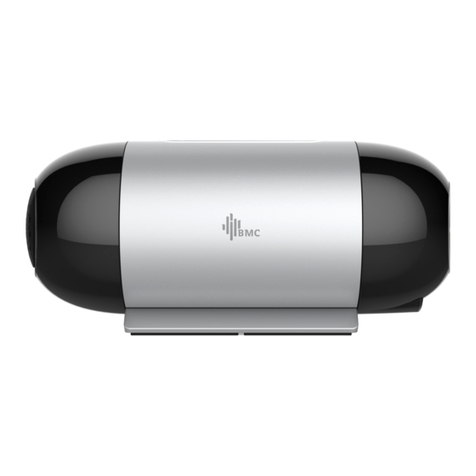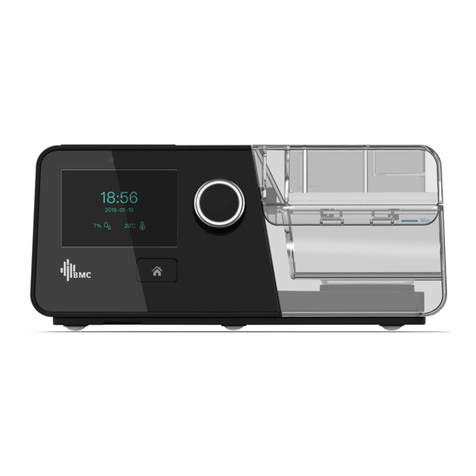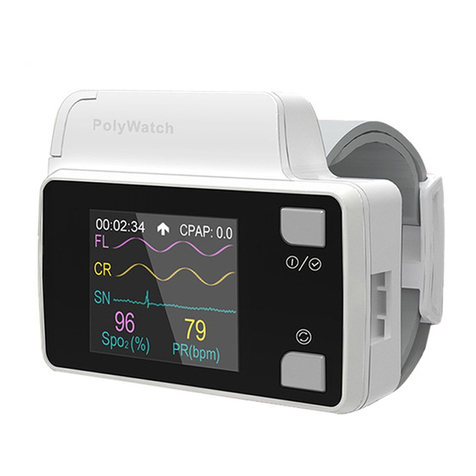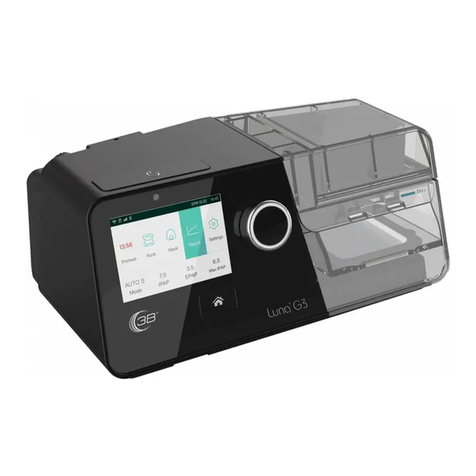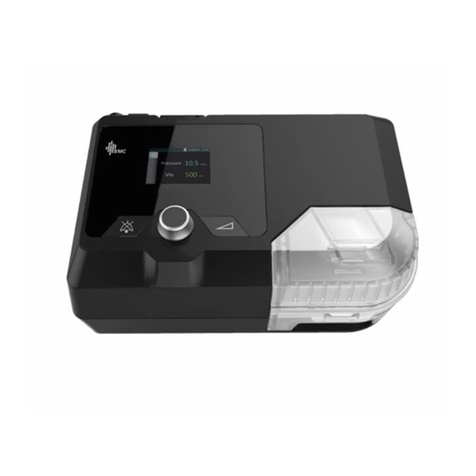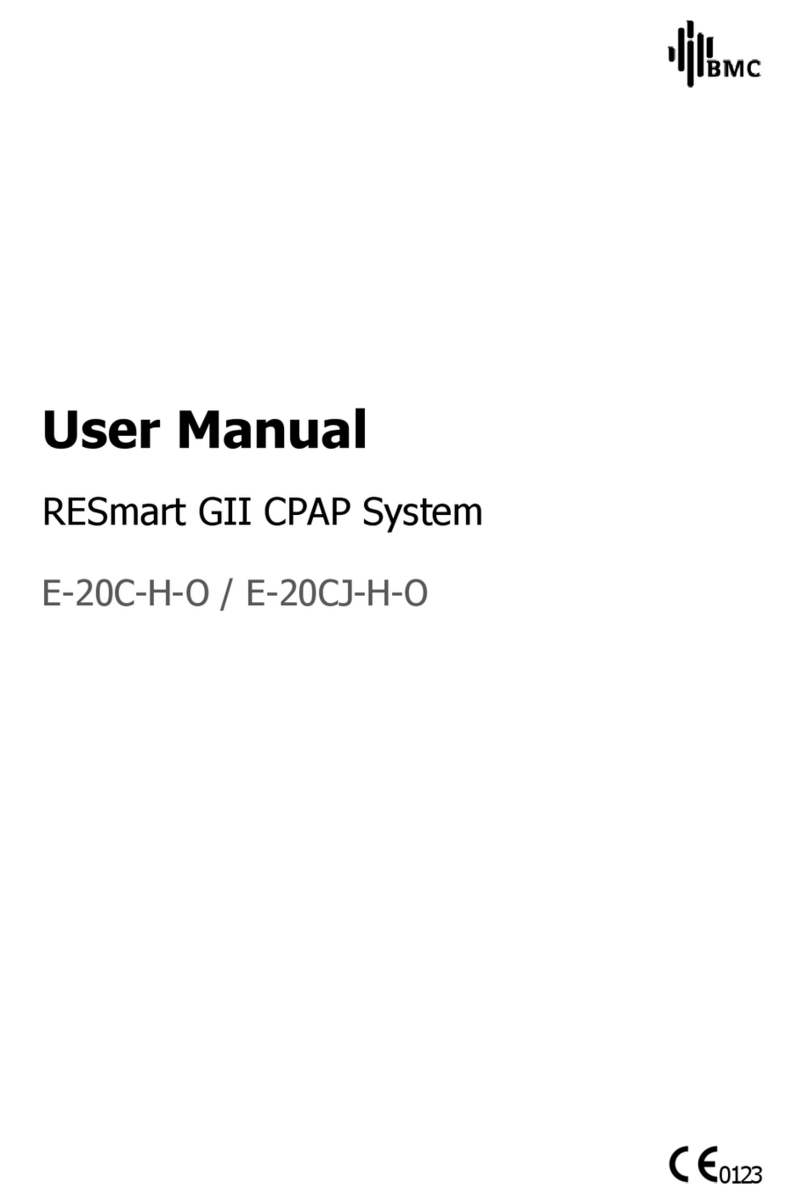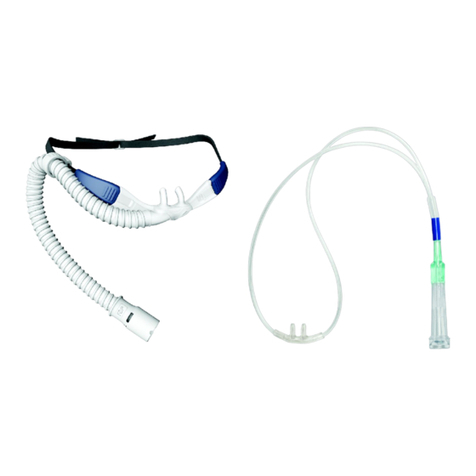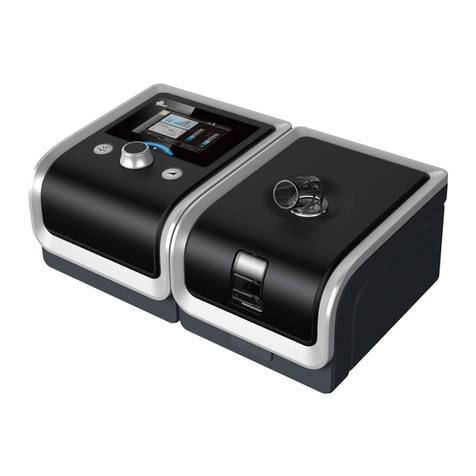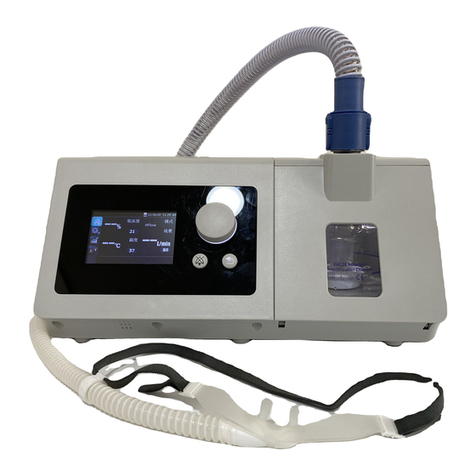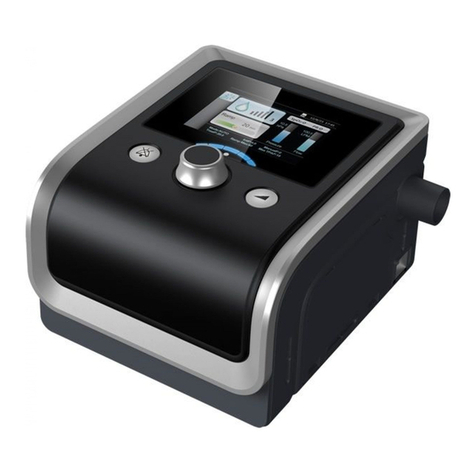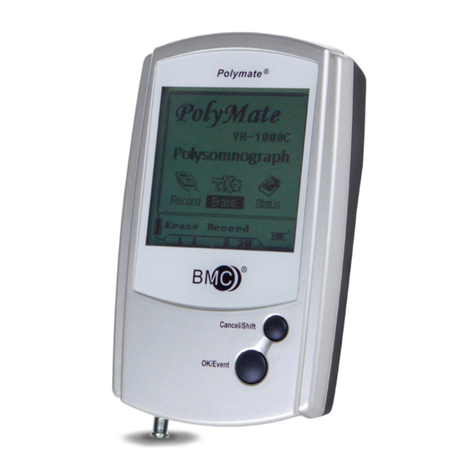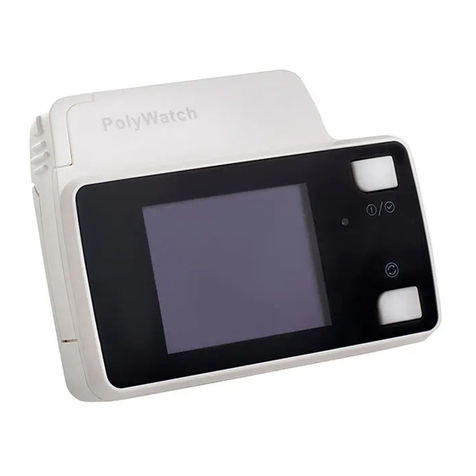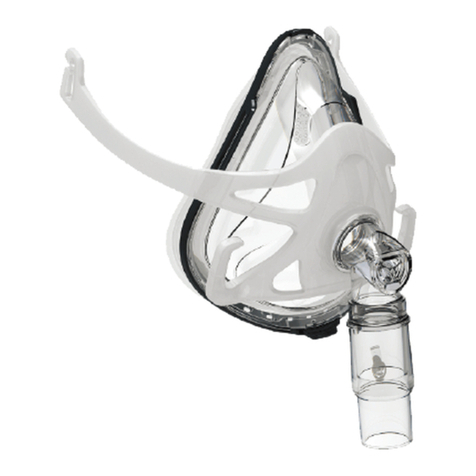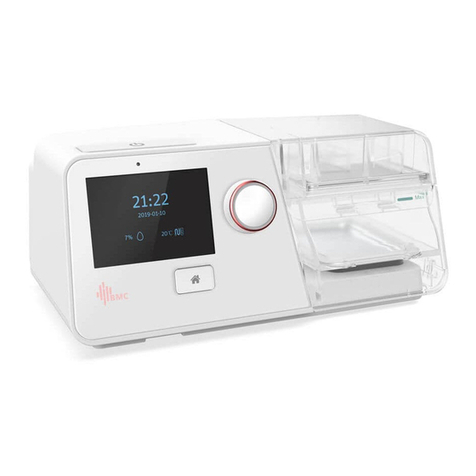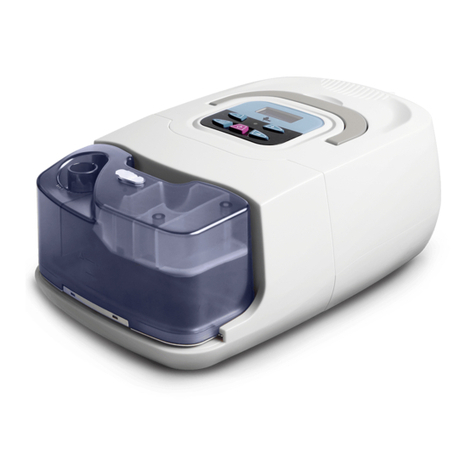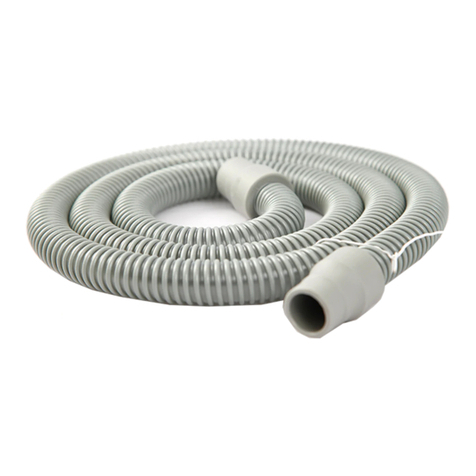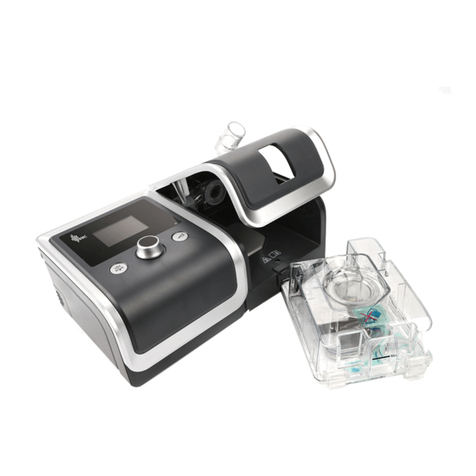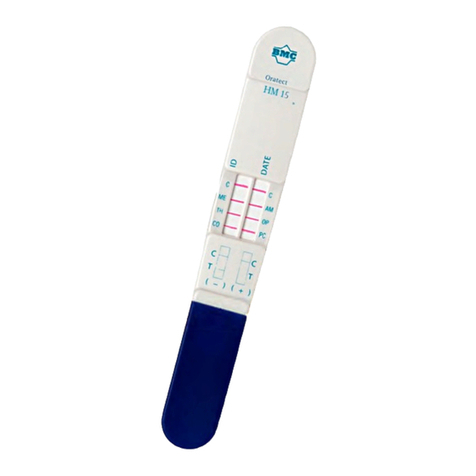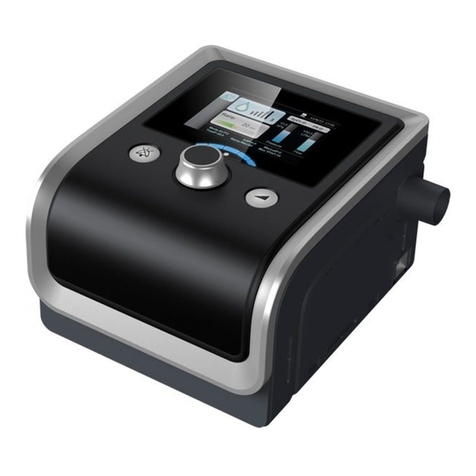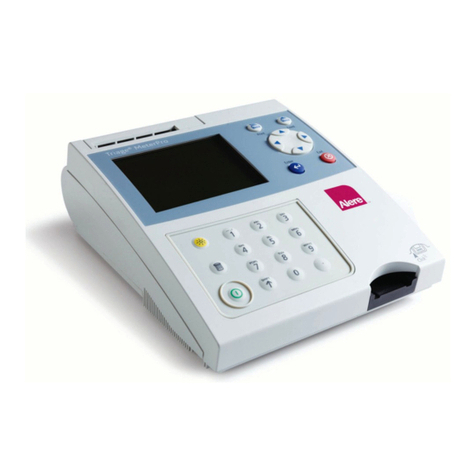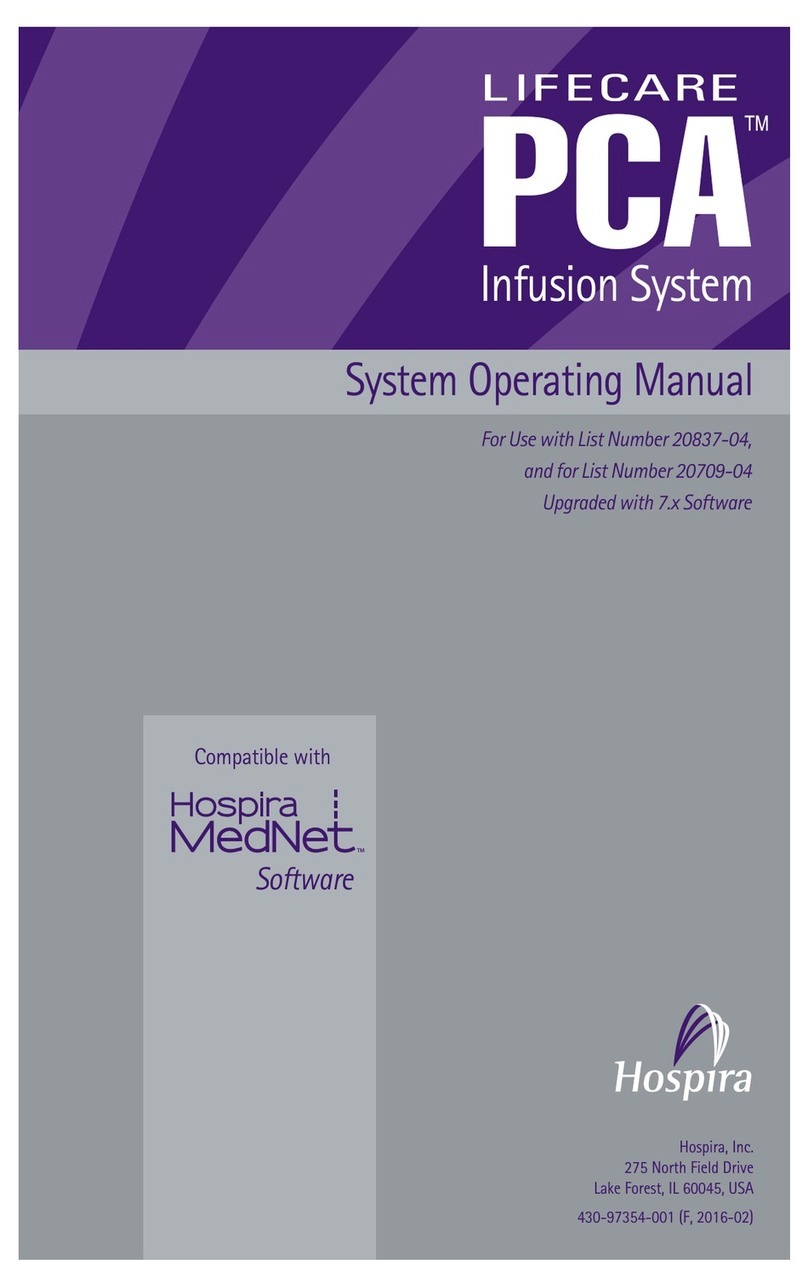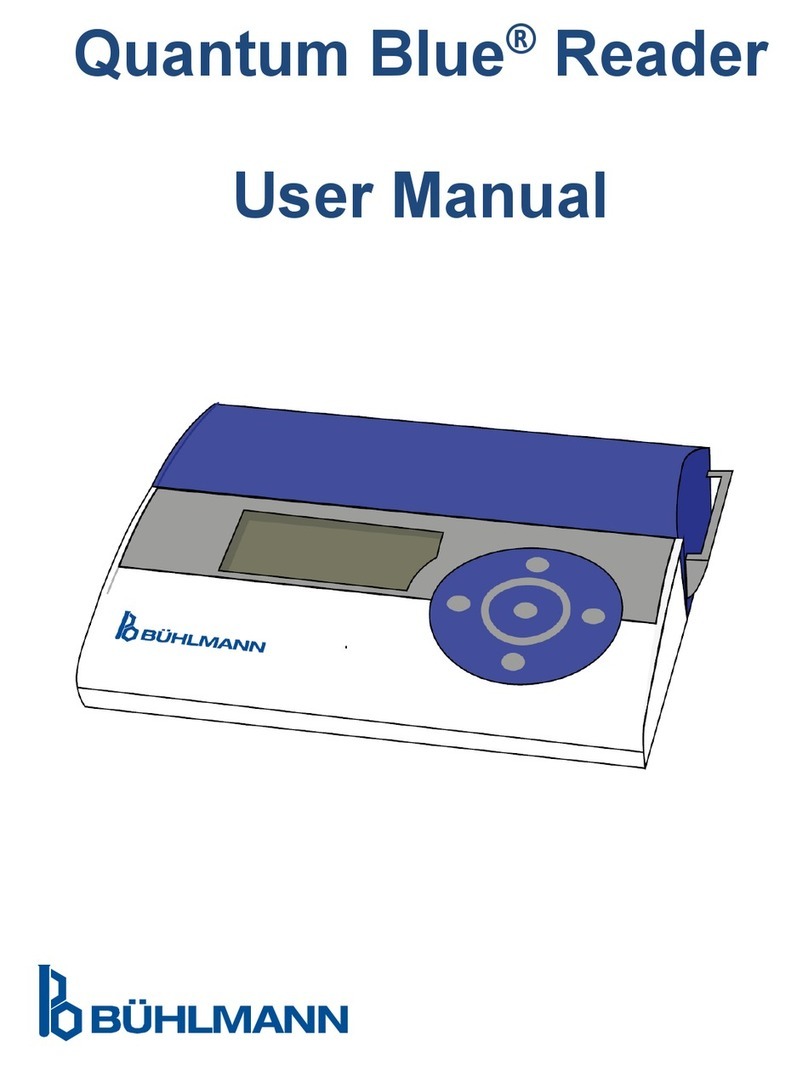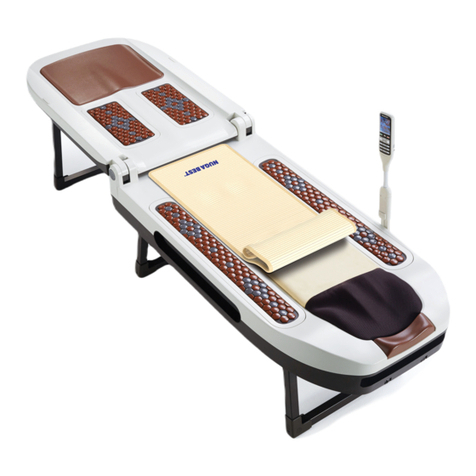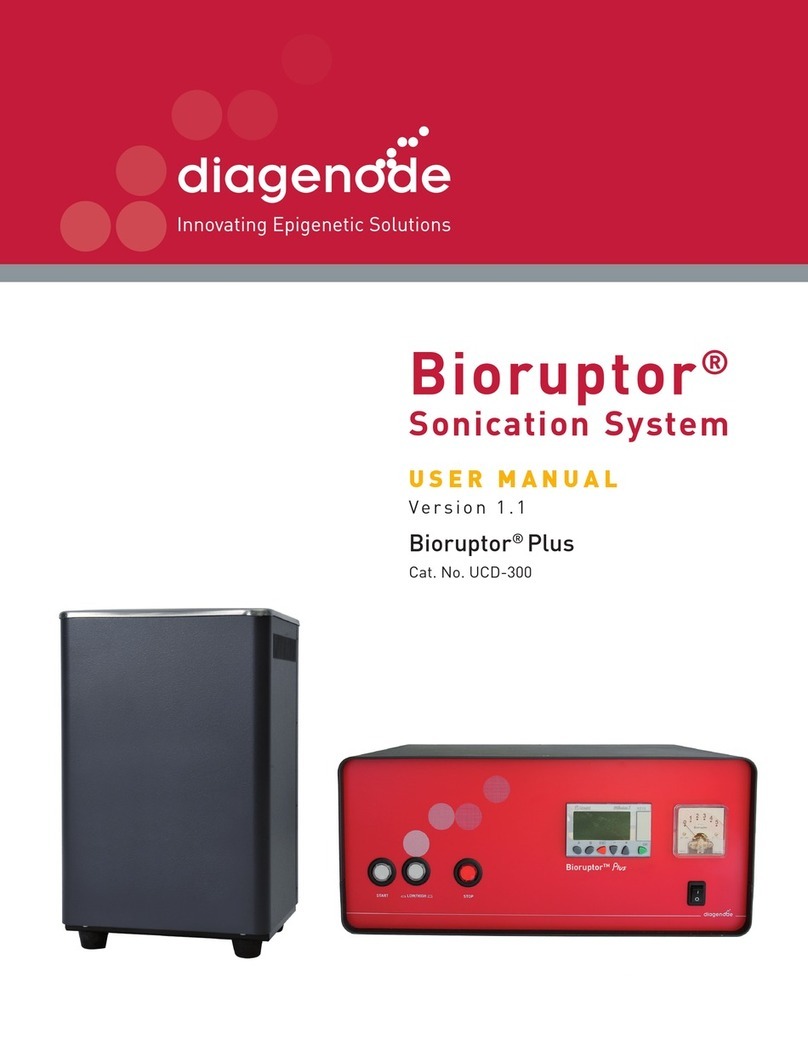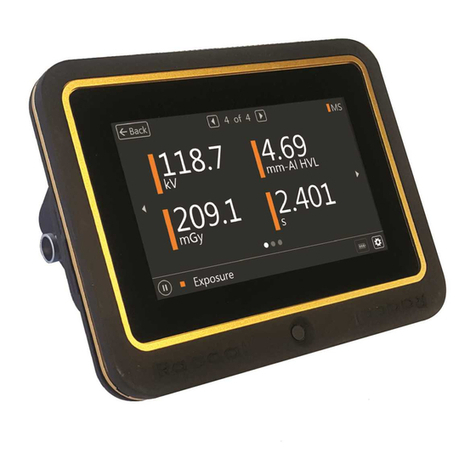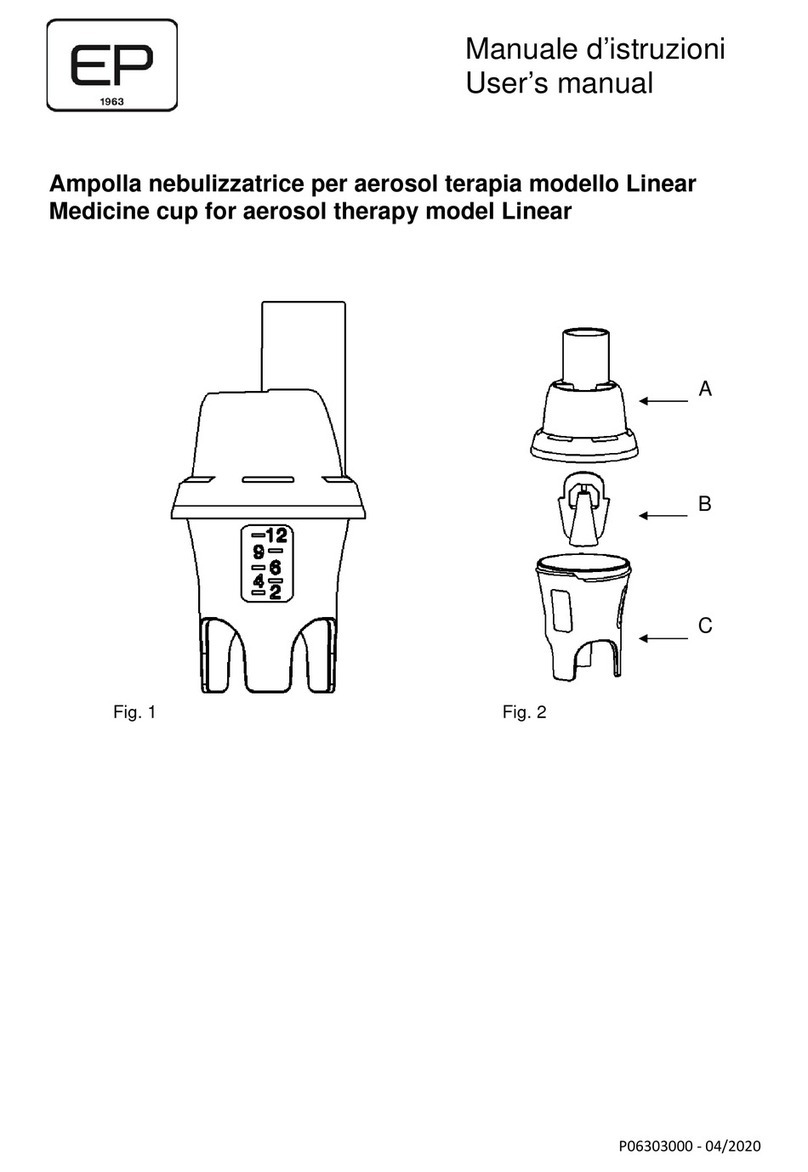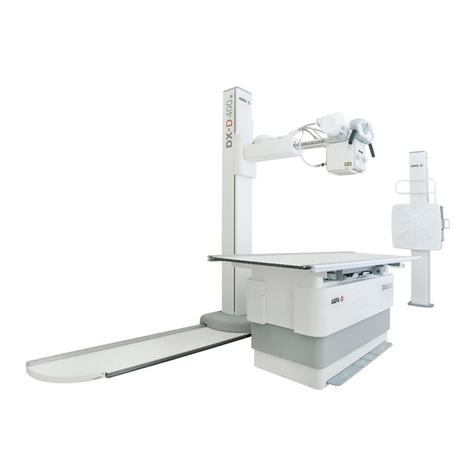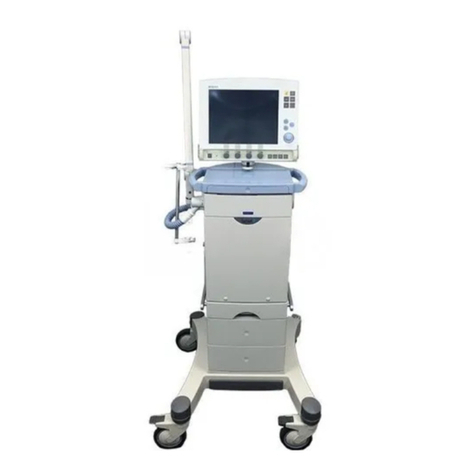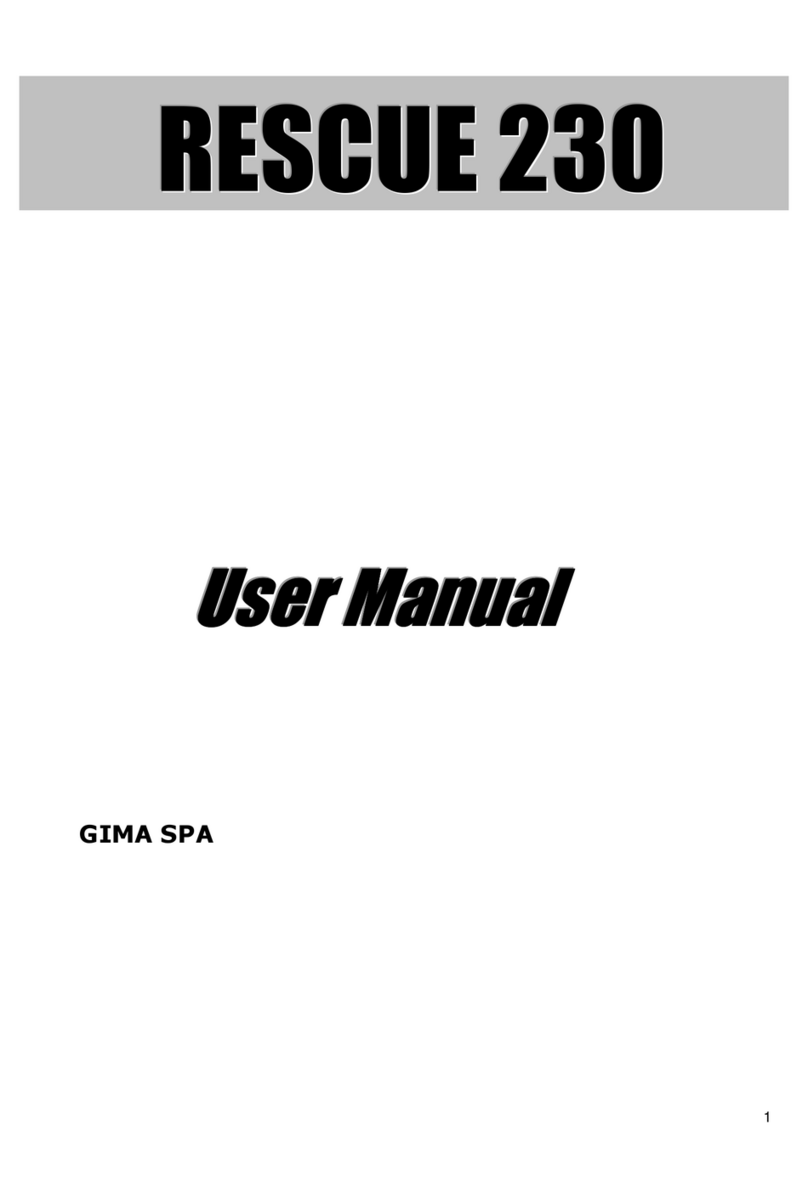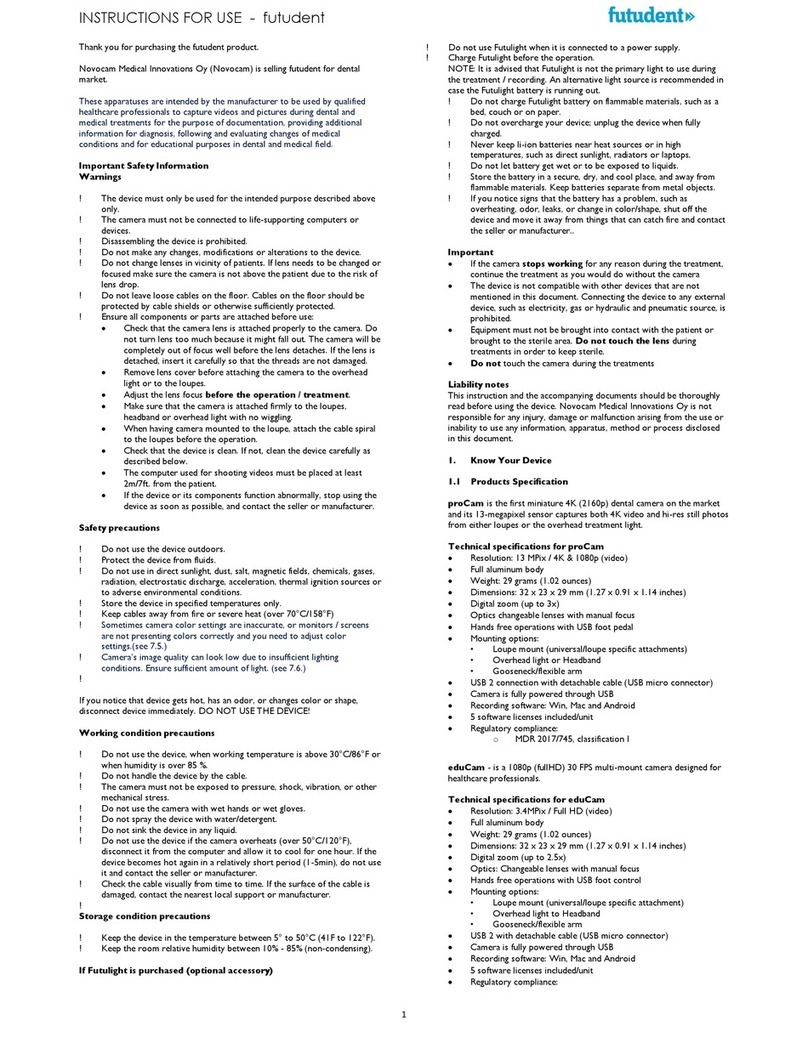BMC G2S BPAP Series User manual

User Manual
Respiratory Insufficiency Ventilator and
Accessories
BPAP System
G2S BPAP Series

G2S BPAP Series User Manual V2.1
Table of Contents
1. Symbols·········································································································1
1.1 Control Buttons····················································································· 1
1.2 Device Symbols····················································································· 1
2. Warning, Caution and Important Tip····································································2
3. Intended Use··································································································3
4. Contraindications····························································································· 4
5. Specifications··································································································4
6. Available Therapies·························································································· 7
7. Glossary·········································································································8
8. Model·········································································································· 10
9. Package Contents·························································································· 11
10. System Features·························································································· 12
11. First Time Setup···························································································13
11.1 Placing the Device·············································································· 13
11.2 Installing the Air Filter and Filter Cap······················································13
11.3 Connecting to Power··········································································· 14
11.4 Connecting to Power Cord Locker·························································· 15
11.5 Assembling the Tube and Mask····························································· 15
11.6 Using Oxygen with the Device·······························································16
11.7 Inserting the SD Card (Only for the device that equipped with SD card)········ 17
11.8 Using the Optional Kits········································································ 18
11.9 Starting Treatment············································································· 18
12. Routine Use································································································ 19
12.1 Connecting the Tube··········································································· 19
12.2 Adjusting the Tube············································································· 19
12.3 Turning on the Airflow········································································· 19
12.4 Heating the Water·············································································· 19
12.5 Using the Ramp Button········································································19
12.6 Turning the Device Off········································································ 19
13. Heated Humidifier························································································ 20
13.1 Filling the Water Chamber····································································20
13.1.1 Removing the Water Chamber··················································· 20
13.1.2 Filling Water···········································································20
13.1.3 Inserting the Water Chamber·····················································21
13.2 Emptying the Water Chamber······························································· 22
13.3 Setting the Humidity Level··································································· 22
14. Navigating the Patient Menu··········································································· 23
14.1 Steps to Navigating the Patient Menu····················································· 23
14.1.1 Accessing the Main Interface····················································· 23

G2S BPAP Series User Manual V2.1
14.1.2 Bringing up the Initial Setup Interface········································· 24
14.1.3 Accessing the Setup Interface···················································· 24
14.1.4 Selecting Options···································································· 24
14.1.5 Adjusting Options···································································· 25
14.1.6 Confirming Adjustments····························································25
14.1.7 Turning Pages········································································· 25
14.1.8 Exiting the Patient Menu··························································· 26
14.2 Options of the Patient Menu and Corresponding Descriptions······················ 27
15. Alarm·········································································································28
15.1 Grading for Alarming and Description····················································· 28
15.2 Visual Alarming·················································································· 28
15.3 Auditory Alarming···············································································28
15.4 Alarming Silence················································································ 29
15.5 Alarming Information and Description·····················································29
15.6 Reposition of Alarming········································································ 32
15.7 Alarming Journal················································································ 32
16. Cleaning and Disinfection··············································································· 32
16.1 Cleaning the Mask and Headgear···························································33
16.2 Cleaning the Optional Kits···································································· 33
16.3 Cleaning the Water Chamber································································ 33
16.4 Cleaning the Enclosure········································································ 34
16.5 Cleaning the Tube·············································································· 34
16.6 Replacing the Air Filter········································································ 34
16.7 Disinfection······················································································· 34
17. Traveling with the Device··············································································· 35
18. Transferring the Device to another Patient························································· 36
19. Reordering·································································································· 36
20. Technical Support························································································· 36
21. Disposal····································································································· 36
22. Troubleshooting··························································································· 37
22.1 Common Problems in Patients and Corresponding Solutions························ 37
22.2 Common Problems in the Device and Corresponding Solutions···················· 39
23. EMC Requirements······················································································· 40
24. Limited Warranty··························································································43

G2S BPAP Series User Manual V2.1
1 / 43
1. Symbols
1.1 Control Buttons
Ramp Button
Mute Button
Knob
1.2 Device Symbols
Follow Instructions for Use
Operating Instructions
Type BF Applied Part (mask and SpO2probe)
Class II (Double Insulated)
/
For indoor use only
AC Power
DC Power
IP22
≥ 12.5 mm Diameter, Dripping (15ºtilted)
There are high-pressure, be careful of electric shock
Hot Surface
Serial Number of the Product
Manufacturer
Authorized Representative in the European Community
Do not use the product if the package is damaged
Disassembly is prohibited
European CE Declaration of Conformity

G2S BPAP Series User Manual V2.1
2 / 43
Product is intended for use by a single patient only
Lot number
Non-Ionizing Radiation
SD Card
Air Inlet
Air Outlet
WEEE Marking
Logo of BMC Medical Co., Ltd.
2. Warning, Caution and Important Tip
WARNING!
Indicate the possibility of injury to the user or operator.
CAUTION!
Indicate the possibility of damage to the device.
IMPORTANT TIP!
Place emphasis on an operating characteristic.
Warnings, Cautions, and Important Tips appear throughout this manual as they apply.

G2S BPAP Series User Manual V2.1
3 / 43
3. Intended Use
BPAP System (G2S BPAP Series) is a Bi-level PAP (Bi-level Positive Airway Pressure) device,
which is intended to provide non-invasive ventilation for patients with obstructive Sleep
Apnea (OSA) and Respiratory Insufficiency. These devices are intended for adult patient by
prescription in the home or hospital/institutional environment.
The optional SpO2module used with the G2S BPAP Series together is indicated for
monitoring the patient's SpO2and pulse rate auxiliarily.
WARNINGS!
• This device is intended for adult use only.
• This device is not intended for life support.
• The instructions in this manual are not intended to supersede established medical
protocols.
• Do not bring the device or accessories into a Magnetic Resonance (MR) environment as it
may cause unacceptable risk to the patient or damage to the device or MR medical devices.
The device and accessories have not been evaluated for safety in an MR environment.
• Do not use the device or accessories in an environment with electromagnetic equipment
such as CT scanners, Diathermy, RFID and electromagnetic security systems (metal
detectors) as it may cause unacceptable risk to the patient or damage to the device. Some
electromagnetic sources may not be apparent, if you notice any unexplained changes in the
performance of this device, if it is making unusual or harsh sounds, disconnect the power
cord and discontinue use. Contact your home care provider.
• Don’t near active HF SURGICAL EQUIPMENT and the RF shielded room of an ME SYSTEM
for magnetic resonance imaging, where the intensity of EM DISTURBANCES is high.
• Several accessories are available to make your treatment with this device as convenient
and comfortable as possible. To ensure that you receive the safe, effective therapy
prescribed for you, use only BMC accessories.
CAUTIONS!
• This device is restricted to sale by or on the order of a physician.
• The device is intended for use by operators trained or experienced in similar equipment.
• The patient is an intended operator.
• Cleaning and disinfection can be performed by the patient.
IMPORTANT TIP!
• Read and understand the entire user manual before operating this system. If you have any
questions concerning the use of this system, contact your home care provider or health care
professional.

G2S BPAP Series User Manual V2.1
4 / 43
4. Contraindications
If you have any of the following conditions, tell your doctor before using this device:
• Insufficient respiratory drive to endure brief interruptions in non-invasive ventilation
therapy
• Acute sinusitis or otitis media
• Epistaxis causing a risk of pulmonary aspiration
• Conditions predisposing to a risk of aspiration of gastric contents
• Impaired ability to clear secretions
• Hypotension or significant intravascular volume depletion
• Pneumothorax or pneumomediastinum
• Recent cranial trauma, cerebrospinal fluid leak or surgery
• Obviously uncooperative or extremely tense
The following side effects may occur during treatment:
- Dryness of the mouth, nose and throat
- Abdominal bloating
- Ear or sinus discomfort
- Eye irritation
- Skin irritation due to the use of a mask
- Chest discomfort
IMPORTANT TIPS!
• An irregular sleep schedule, alcohol consumption, obesity, sleeping pills, or sedatives may
aggravate your symptoms.
• Please use the mask which meets ISO17510:2015 and ISO 18562.
CAUTION!
• Contact your health care professional if symptoms of sleep apnea recur. Contact your
health care professional if you have any questions concerning your therapy.
5. Specifications
Device Size
Dimensions: 274 mm × 184 mm × 115 mm
Weight: 1.9 kg
Water capacity: To maximum fill line 360 mL
Product Use, Transport and Storage
Operation Transport and Storage
Temperature: 5°C to 35°C (41˚F to 95˚F) -25°C to 70°C (-13˚F to 158˚F)
Humidity: 15% to 93% Non-condensing 15% to 93% Non-condensing
Atmospheric Pressure: 760 to 1060 hPa 760 to 1060 hPa

G2S BPAP Series User Manual V2.1
5 / 43
Heated Humidifier
Humidifier Settings: Off, 1 to 5 (95˚F to 154.4˚F / 35°C to 68°C)
Humidifier Output: No less than 10 mg H2O/L
Environmental Conditions: Maximum airflow, 35°C, 15% relative humidity
Maximum Delivered Gas Temperature: ≤ 43°C
Mode of Operation
Continuous
Work Mode
CPAP, S, AutoS, AutoCPAP, S/T, T
SD Card
SD card can record patient data and fault information.
AC Power Consumption
100 -240 V ~, 50 / 60 Hz, Max 2 A
Main Device offer to USB Communications Port
5 V 2.0 A
Type of Protection against Electric Shock
Class II Equipment
Degree of Protection against Electric Shock
Type BF Applied Part
Degree of Protection against Ingress of Water
IP22
Pressure Range
IPAP: 4.0 ~20.0 hPa (only applies to G2S B20A, G2S B20S, G2S B20T);
4.0 ~25.0 hPa (only applies to G2S B25A, G2S B25S, G2S B25T, G2S B25VT, G2S LAB);
4.0 ~30.0 hPa (only applies to G2S B30T, G2S B30VT, G2S B30AT);
in 0.5 hPa increments.
EPAP: 4.0 ~20.0 hPa (only applies to G2S B20A, G2S B20S, G2S B20T);
4.0 ~25.0 hPa (only applies to G2S B25A, G2S B25S, G2S B25T, G2S B25VT, G2S
B30T, G2S B30VT, G2S B30AT, G2S LAB);
in 0.5 hPa increments.
CPAP and AutoCPAP mode: 4.0 ~20.0 hPa
Under single fault conditions, ≤ 30 hPa for CPAP mode, ≤ 40 hPa for the rest modes.
Pressure Display Accuracy
± (0.8 hPa+4%)
Static Pressure Stability
± 0.5 hPa
Ramp
The ramp time ranges from 0 to 60 minutes.

G2S BPAP Series User Manual V2.1
6 / 43
Sound Pressure Level
< 30 dB, when the device is working at the pressure of 10 hPa.
Sound Power Level
< 38 dB, when the device is working at the pressure of 10 hPa.
Maximum Flow
For models with a maximum pressure of 20 hPa, the flow table is as follows.
Test Pressure (hPa)
4
8
12
16
20
Measured Pressure at the Patient
Connection Port (hPa)
3
7
11
15
19
Average Flow at the Patient
Connection Port (L/min)
90
150
150
150
145
When the working pressure is set to the values listed in the table, the average flow rate at
the patient end should be greater than 80% of the corresponding flow value in the table.
For models with a maximum pressure of 25 hPa, the flow table is as follows.
Test Pressure (hPa)
4
10
15
20
25
Measured Pressure at the Patient
Connection Port (hPa)
3
9
14
19
24
Average Flow at the Patient
Connection Port (L/min)
90
150
150
145
110
When the working pressure is set to the values listed in the table, the average flow rate at
the patient end should be greater than 80% of the corresponding flow value in the table.
For models with a maximum pressure of 30 hPa, the flow table is as follows.
Test Pressure (hPa)
4
11
17
24
30
Measured Pressure at the Patient
Connection Port (hPa)
3
10
16
23
29
Average Flow at the Patient
Connection Port (L/min)
90
150
150
120
85
When the working pressure is set to the values listed in the table, the average flow rate at
the patient end should be greater than 80% of the corresponding flow value in the table.
SpO2
Range: 0 ~100%
The margin of error for SpO2between 70% and 100% is ± 3%. No strict accuracy
requirements for SpO2below 70%.
Pulse Rate
Range: 40 ~240 BPM
Margin of Error: ± 1%
Wavelengths
Red: 663 nanometers
Infrared: 890 nanometers
Maximal Optical Output Power
Less than 1.5 mW maximum average.

G2S BPAP Series User Manual V2.1
7 / 43
Tube
Length: 6 ft. (1.8 m)
The Form and the Dimensions of the Patient Connection Port
The 22 mm conical air outlet complies with ISO 5356-1.
Power of heating components
38 W
6. Available Therapies
The device delivers the following therapies:
CPAP
–
Delivers Continuous Positive Airway Pressure; CPAP maintains a constant level of
pressure throughout the breathing cycle. If your health care professional has prescribed
ramp for you, you can press the Ramp Button to reduce the pressure and then
gradually increase the pressure to the therapeutic pressure setting so that you can fall asleep
more comfortably.
AutoCPAP
–
Delivers CPAP therapy and provides an air pressure no less than the prescribed
one based on the patient’s needs.
AutoS
–
A bi-level mode which responds to both your inhalation and exhalation. The
differential pressure of IPAP and EPAP are presetted by home care provider. While working in
auto feature, the device will automatically adjust the IPAP and EPAP if it detects a sleep
apnea.
S
–
A bi-level mode which responds to both your inhalation and exhalation by increasing
pressure when you start to inhale and decreasing pressure when you start to exhale. There is
no automatic delivery of a breath you do not inhale. IPAP (Inspiratory Positive Airway
Pressure) and EPAP (Expiratory Positive Airway Pressure) are preset by home care provider.
S/T
–
A bi-level mode which responds to both your inhalation and exhalation by increasing
pressure when you start to inhale and decreasing pressure when you start to exhale. If you
do not start inhaling within a set time, the device automatically starts inhalation. When the
device starts inhalation, it controls the time of inhalation and automatically decreases the
pressure for exhalation within a set time.
T
–
A bi-level mode which the device automatically starts inhalation and exhalation,
automatically controls the time of inhalation and that of exhalation according to the preset
parameter.

G2S BPAP Series User Manual V2.1
8 / 43
7. Glossary
Apnea
A condition marked by the cessation of spontaneous breathing.
AutoCPAP
Adjust CPAP pressure automatically to improve patient comfort based on monitoring of
apnea and snoring events.
Auto Off
When this feature is enabled, the device automatically discontinues therapy whenever the
mask is removed.
Auto On
When this feature is enabled, the device automatically initiates therapy when you breathe
into the mask.
CPAP
Continuous Positive Airway Pressure.
EPAP
Expiratory Positive Airway Pressure.
IPAP
Inspiratory Positive Airway Pressure.
iCode
A feature that is intended to give access to compliance and therapy management information.
The “iCode” consists of six separate codes displayed in the Patient Menu, each code is a
sequence of numbers. The “iCode QR” and “iCode QR+” display two-dimensional codes.
LPM
Liters Per Minute.
OSA
Obstructive Sleep Apnea.
Patient Menu
The display mode in which you can change patient-adjustable device settings, such as the
starting pressure for the Ramp feature.
Ramp
A feature that may increase patient comfort when therapy is started. It can reduce pressure
and then gradually increase the pressure to the prescription setting so the patient can fall
asleep more comfortably.
Rise Time
The time it takes for the device to change from EPAP to IPAP. You can adjust this time for
your comfort.

G2S BPAP Series User Manual V2.1
9 / 43
Res Rate
Respiratory Rate. Number of breaths per minute.
Reslex
A therapy feature that is enabled by your home care provider to provide pressure relief
during exhalation.
Standby State
The state of the device when power is applied but the airflow is turned off.
min
Means the time unit “minute”.
h
Means the time unit “hour”.
yy mm dd / mm dd yy / dd mm yy
Denotes date.

G2S BPAP Series User Manual V2.1
10 / 43
8. Model
Model
Product Contents
Work Mode
Maximum
Work
Pressure
(hPa)
Main Device
Optional
Accessory
G2S B20S
Main device
(2.4-inch TFT)
Tube, Mask,
Cellular Module,
SpO2Kit,
SpO2&GPRS Kit
CPAP, S
20
G2S B20A
Main device
(2.4-inch TFT)
CPAP, S, AutoS
20
G2S B20T
Main device
(2.4-inch TFT)
CPAP, S, S/T, T
20
G2S B25S
Main device
(3.5-inch TFT)
CPAP, S
25
G2S B25A
Main device
(3.5-inch TFT)
CPAP, S, AutoS
25
G2S B25T
Main device
(3.5-inch TFT)
CPAP, S, S/T, T
25
G2S B25VT
Main device
(3.5-inch TFT)
CPAP, S, S/T, T
25
G2S LAB
Main device
(3.5-inch TFT)
CPAP, S, AutoS,
AutoCPAP, S/T, T
25
G2S B30T
Main device
(3.5-inch TFT)
CPAP, S, S/T, T
30
G2S B30VT
Main device
(3.5-inch TFT)
CPAP, S, S/T, T
30
G2S B30AT
Main device
(3.5-inch TFT)
CPAP, S, AutoS,
AutoCPAP, S/T, T
30

G2S BPAP Series User Manual V2.1
11 / 43
9. Package Contents
After unpacking the system, make sure you have everything shown here (Different models of
the product may contain different components):
No.
Articles
Qty.
Notes
1
Device
1
2
Air Filter
2
3
Power Adapter
1
4
Power Cord
1
5
Mask
1
Optional
6
Cellular Module
1
Optional
7
SpO2Kit
1
Optional
8
SpO2&GPRS Kit
1
Optional
9
Tube
1
Optional
10
SD Card
1
Optional
11
Carrying Case
1
Optional
12
Accompanying Documents
1
13
Power Cord Locker
1
All parts and accessories are not made with natural rubber latex.
The service life of the device is five years if the use, maintenance, cleaning and disinfection
are in strict accordance with the User Manual.
The service life of the tube is 6 months. The service life of the mask is 1 year.
The mask and SpO2Probe are applied part.
IMPORTANT TIPS!
• If any of the above parts are missing, contact your home care provider.
• Contact your home care provider for additional information on the available accessories of
this device. When using optional accessories, always follow the instructions enclosed with
the accessories.
• The tube with a diameter of 15 mm or 22 mm is available.
WARNINGS!
• This device should only be used with the mask and accessories manufactured or
recommended by BMC or with those recommended by your prescribing physician. The use of
inappropriate masks and accessories may affect the performance of the device and impair
the effectiveness of therapy.
• Use of accessories, transducers and cables other than those specified or provided by the
manufacturer of this device could result in increased electromagnetic emissions or decreased
electromagnetic immunity of this equipment and result in improper operation.
• Use of this device adjacent to or stacked with other equipment should be avoided because
it could result in improper operation. If such use is necessary, this equipment and the other
equipment should be observed to verify that they are operating normally.
• When the insulation layer of the SpO2probe cable is damaged, do not connect the probe to
the patient.

G2S BPAP Series User Manual V2.1
12 / 43
• Do not stack the long tubing or SpO2Kit lead near the patient’s neck, as it may wrap around
the patient’s head or neck during sleep.
• Do not connect any equipment to the device unless recommended by BMC or your health
care provider.
• Please contact BMC to obtain an SD card if needed.
10. System Features
Fig. 10-1
Name
Function
Humidifier
Indicator
Indicate the humidity level. There are five levels in total. The
number of indicator lights that light up is directly proportional to the
humidity level. If the indicator lights are off, it means the humidifier
is turned off
Mute Button
Press this button to mute the alert. However, if the problem causing
the alert is not solved, the alert will sound again two minutes later
Knob
Start treatment and adjust device settings
Ramp Button
Enable the Ramp feature
Display Screen
Display menus for operation, messages, monitoring data, etc.
Power Indicator
Indicate the power supply status
Fig. 10-2
Name
Function
SD Card Slot
Insert the SD card into this slot
Air Outlet
Deliver pressurized air; connects to the tube
Communications
Port
Connected to external equipment (Not for connection to
un-recommended devices)
DC Inlet
An inlet for the DC power supply
Filter Cap
(Air Inlet)
Place the cap on the air filter, which is used to filter dust and pollen
in the air entering the device

G2S BPAP Series User Manual V2.1
13 / 43
CAUTION!
• The pictures in this manual are only for reference, if they are different from the material
object, the latter shall prevail.
11. First Time Setup
11.1 Placing the Device
Place the device on a firm, flat surface.
WARNINGS!
• If the device has been dropped or mishandled, if the enclosure is broken, or if water has
entered the enclosure, disconnect the power cord and discontinue use. Contact your home
care provider immediately.
• If the room temperature is warmer than 95˚F (35°C), the airflow produced by the device
may exceed 109.4˚F (43°C). The room temperature must be kept below 95˚F (35°C) while
the patient uses the device.
CAUTIONS!
• If the device has been exposed to either very hot or very cold temperatures, allow it to
adjust to room temperature (approximately 2 hours) before beginning setup.
• Make sure the device is away from any heating or cooling equipment (e.g., forced air vents,
radiators, air conditioners).
• The device is not suitable for use in high humidity environments. Make sure that no water
enters the device.
• Make sure that bedding, curtains, or other objects (such as pests) are not blocking or
entering the filter or vents of the device.
• Keep pets, pests or children away from the device and avoid small objects being inhaled or
swallowed.
• To avoid explosion, this device must not be used in the presence of flammable gases (e.g.
anesthetics).
• Tobacco smoke may cause tar build-up within the device, leading to the malfunctioning of
the device.
• Air must flow freely around the device for it to work properly.
11.2 Installing the Air Filter and Filter Cap
(1) Attach the air filter to the filter cap, as shown in Fig. 11-1.
Fig. 11-1

G2S BPAP Series User Manual V2.1
14 / 43
(2) Install the filter cap containing the air filter to the device, as shown in Fig. 11-2.
Fig. 11-2
CAUTIONS!
• The air filter must be in place when the device is operating.
• Installing the air filter and filter cap, device must be unplugged.
11.3 Connecting to Power
(1) Insert the plug of the power adapter into the DC Inlet on the back of the device;
(2) Connect the power cord to the power adapter;
(3) Plug the other end of the power cord into the power outlet.
Fig. 11-3
Note: The length of the power cord and power adapter is 1.5 m and 1.8 m respectively
without the function of preventing electromagnetic interference.
WARNINGS!
• The device is powered on for use when the power cord and power adapter is connected.
The Knob turns the blower On / Off.
• Use of the device at an AC voltage beyond the stated range (see Section 5 “AC Power
Consumption”) may damage the device or cause device failure.
• Connect to appropriate power for proper operation of the device.
CAUTION!
• Inspect the power cord often for any signs of damage. Replace a damaged cord immediately.

G2S BPAP Series User Manual V2.1
15 / 43
IMPORTANT TIPS!
• After interruption and restoration of the power supply, the device will restore its
pre-interruption working status automatically.
• To remove AC power, disconnect the power cord from the power outlet.
11.4 Connecting to Power Cord Locker
(1) Assemble the power cord locker to the device directed by the positioning groove.
Fig. 11-4
(2) Open the power cord locker, plug the power cord to the power supply, and press the
locker downward to fix the power cord into the power port.
Fig. 11-5
The function of the locker is to prevent the power cord falling off from the power port.
11.5 Assembling the Tube and Mask
(1) Connect one end of the tube to the air outlet of the main device, as shown in Fig. 11-6.

G2S BPAP Series User Manual V2.1
16 / 43
Fig. 11-6
(2) Connect the other end of the tube to the mask according to the user manual for the mask.
Wear the mask.
WARNINGS!
• If multiple persons are going to use the device (e.g., rental devices), a low-resistance, main
flow bacteria filter should be installed in-line between the device and tube. Pressures must
be verified by your home care provider when alternate or optional accessories are in place.
• If you are using a mask with a built-in exhalation port, connect the mask’s connector to the
tube.
• If you are using a mask with a separate exhalation port, connect the tube to the exhalation
port. Position the exhalation port so that the vented air is blowing away from your face.
Connect the mask’s connector to the exhalation port.
• If you are using a full-face mask (a mask covering both your mouth and nose), the mask
must be equipped with a safety (entrainment) valve.
• In order to minimize the risk of CO2rebreathing, the patient should observe the following
instructions:
- It is recommended to use the accompanying tube and mask provided by BMC.
- Do not wear the mask for more than a few minutes while the device is not operating.
- Use only masks with vent holes. Do not block or try to seal the vent holes in the exhalation
port.
CAUTION!
• When using the tube with a diameter of 15mm, set the tube of the Patient Menu to 15 mm
(see Section 14.2 “Options of the Patient Menu and Corresponding Descriptions”).
11.6 Using Oxygen with the Device
Oxygen may be added at the mask connection. Please observe the instructions listed below
when using oxygen with the device.
WARNINGS!
• Connect the oxygen tube to the oxygen inlet of the mask.
• The oxygen supply must comply with the local regulations for medical oxygen.
• Turn on the device before turning on the oxygen. Turn off the oxygen before turning off the

G2S BPAP Series User Manual V2.1
17 / 43
device. Explanation of Warning: When the device is turned off, but the oxygen flow still exists,
oxygen may accumulate within the device's enclosure and pose a fire hazard. Turning off the
oxygen before turning off the device will prevent oxygen accumulation in the device and
reduce the risk of fire. This warning applies to most devices.
• Oxygen supports combustion. Keep the device and the oxygen container away from heat,
open flames, any oily substances, or other sources of ignition. DO NOT smoke in the area
near BPAP System or the oxygen container.
• Sources of oxygen should be located more than 1 m from the device.
• When using oxygen with this system, a Pressure Valve must be placed in-line with the
patient circuit between the device and the oxygen source. The pressure valve helps prevent
the backflow of oxygen from the patient circuit into the device when the unit is off. Failure to
use the pressure valve could result in a fire hazard.
• Do not connect the device to an unregulated or high pressure oxygen source. The pressure
of oxygen source does not exceed the work pressure of the device.
11.7 Inserting the SD Card (Only for the device that
equipped with SD card)
Insert the SD card into the SD Card Slot, as shown in Fig. 11-7.
Fig. 11-7
If the SD card is inserted correctly, a symbol indicating correct insertion will appear in the
Main Interface on the screen of the device, as shown in Fig. 11-8.
Fig. 11-8
If the SD card is inserted incorrectly, a symbol indicating incorrect insertion will appear in the
Main Interface on the screen of the device, as shown in Fig. 11-9.
Other manuals for G2S BPAP Series
1
This manual suits for next models
11
Table of contents
Other BMC Medical Equipment manuals
Popular Medical Equipment manuals by other brands

Leica
Leica M501 user manual
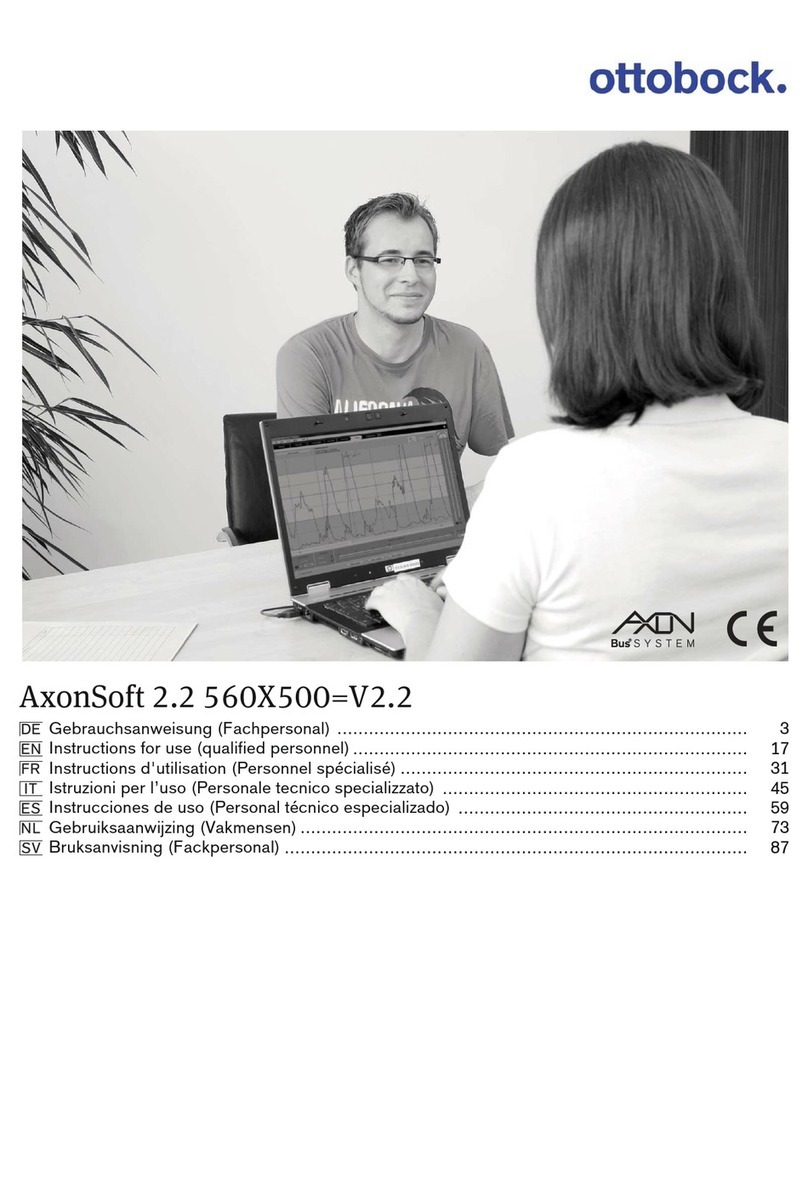
Otto Bock
Otto Bock AxonSoft 2.2 560X500 V2.2 Instructions for use

Dräger
Dräger Evita V800 Pocket guide
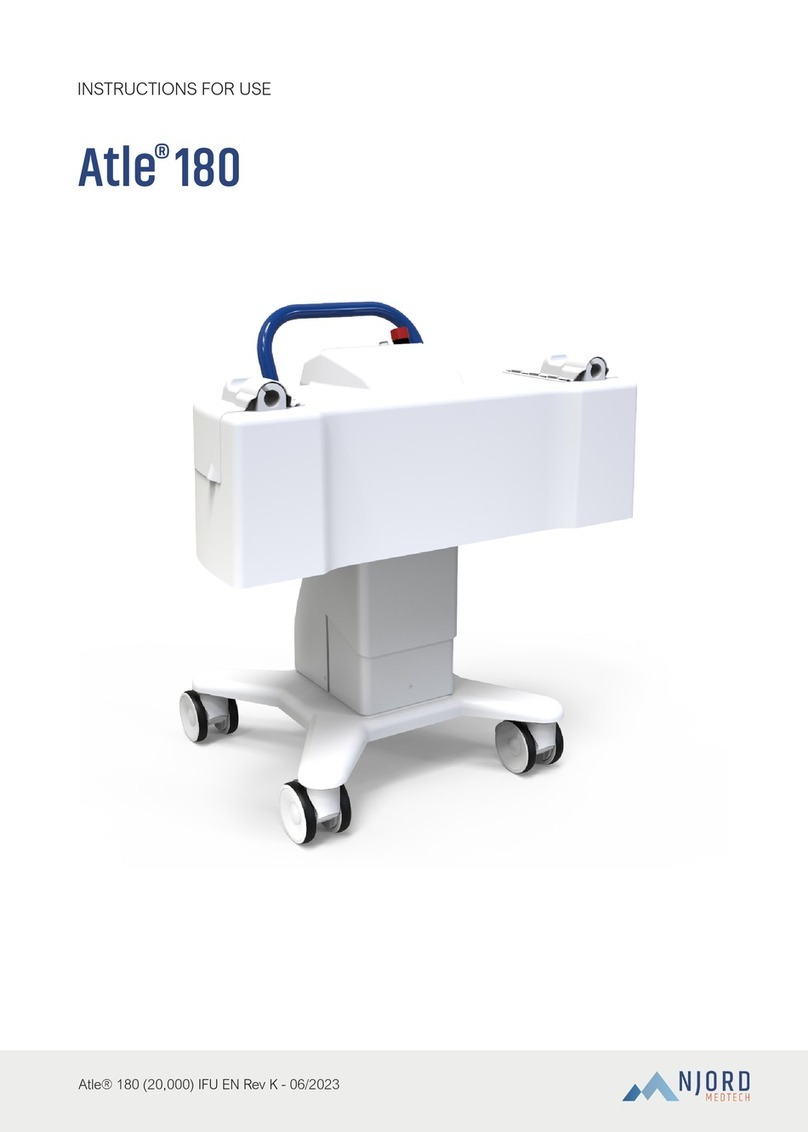
NJORD
NJORD Atle 180 Instructions for use
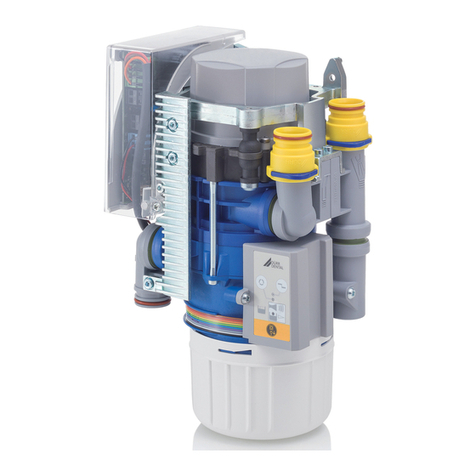
Durr Dental
Durr Dental CAS 1 Installation and operating instructions
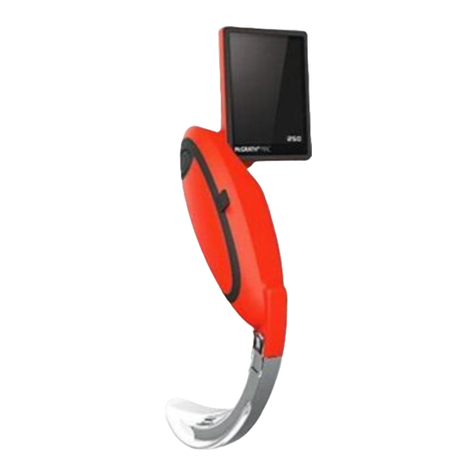
Aircraft Medical
Aircraft Medical McGRATH MAC EMS Operator's manual
